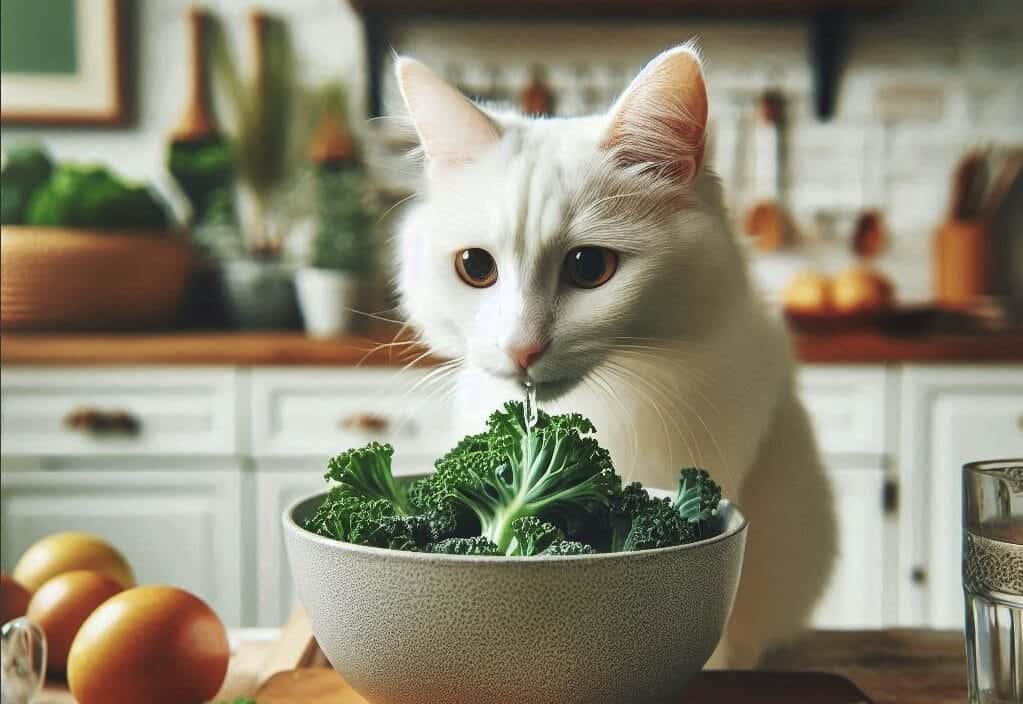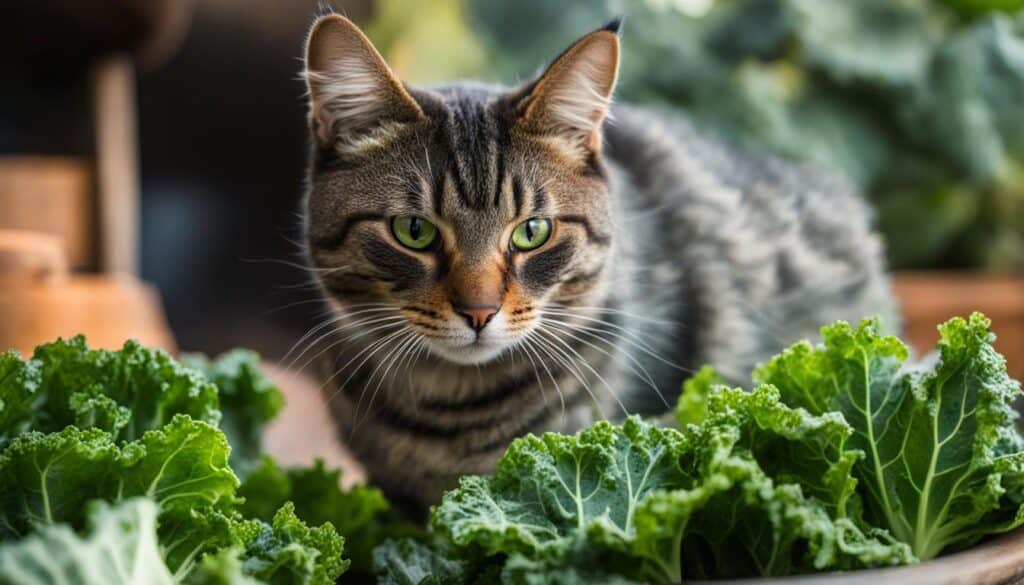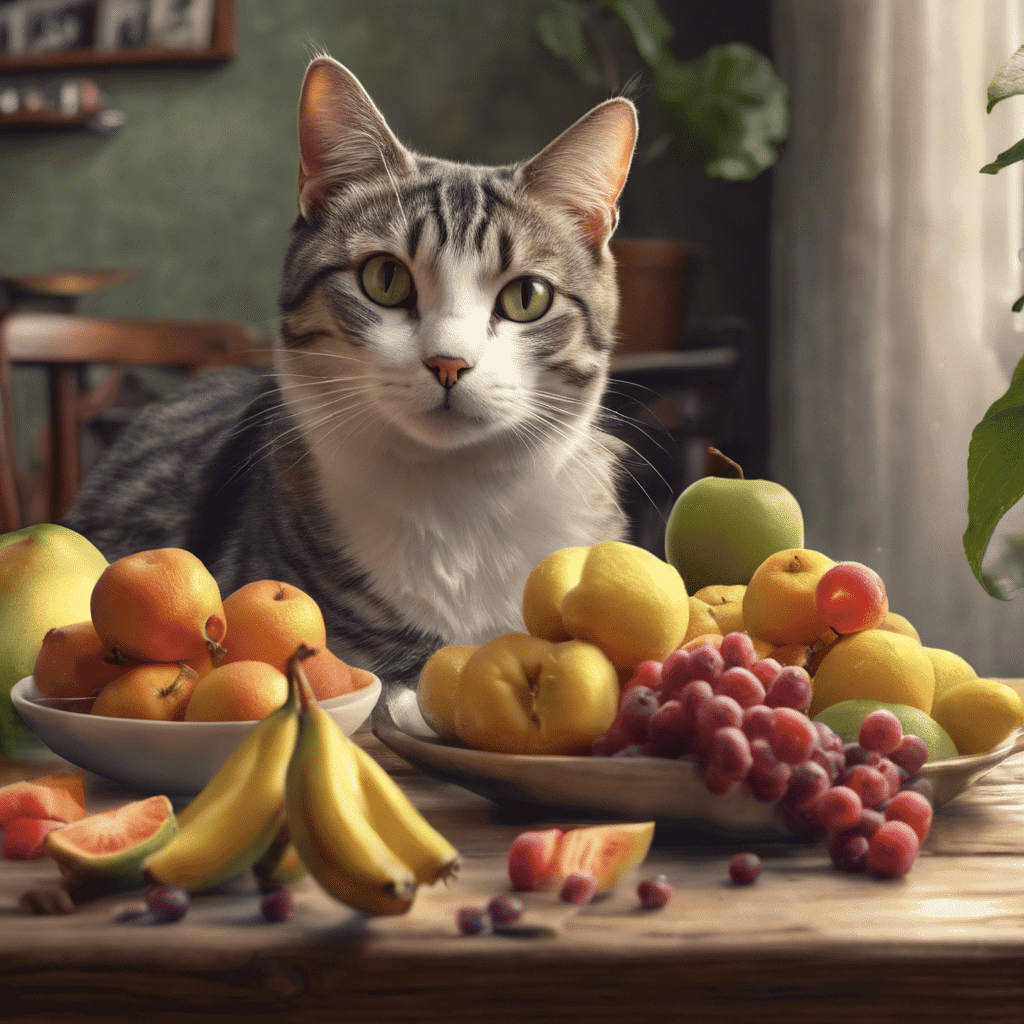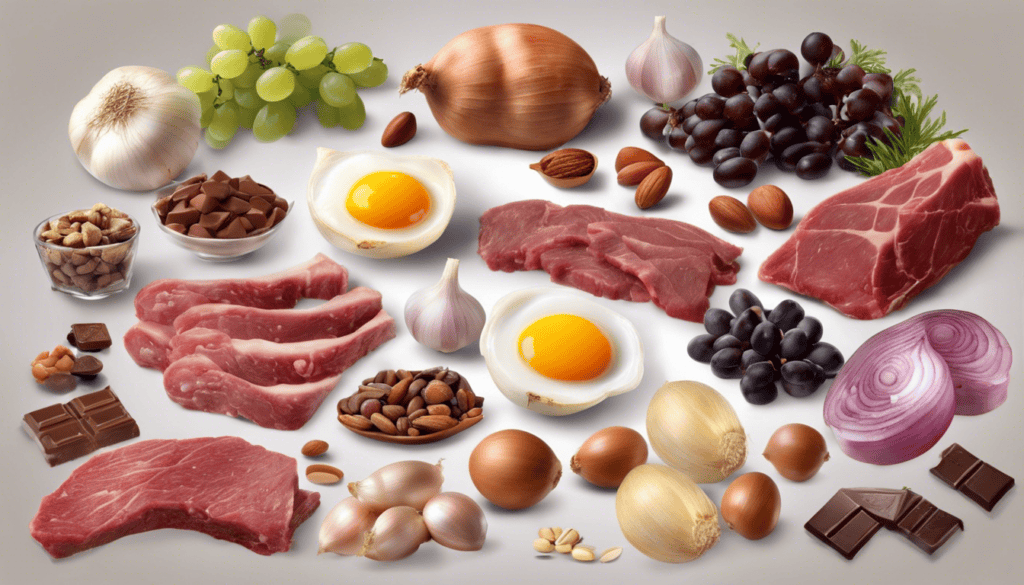
A balanced diet is essential for maintaining the overall health and well-being of cats. As a cat owner, I frequently question various foods’ safety, with kale being a common topic. So, can cats eat kale?
In this article, we’ll discuss:
- The basics of cat nutrition
- The nutritional profile of kale
- Whether kale is safe for cats
- Potential benefits and risks of feeding kale to your feline friend
Understanding Cat Nutrition
Cats are considered obligate carnivores, which means their bodies are designed to thrive on a diet primarily composed of meat. This obligate carnivore status is rooted in their evolutionary history, where they relied on hunting prey for survival. As a result, cats require specific nutrients that are predominantly found in animal-based proteins.
Did you know that an important component of a cat’s diet is high-quality commercial cat food? These foods are formulated to provide essential nutrients such as taurine and arachidonic acid, which are vital for maintaining heart health, vision, and reproductive function. Cats cannot synthesize these nutrients themselves, thus making it imperative that their diet includes them.
Here are some key points to remember about your cat’s diet:
- Animal-based protein should be the primary source of nutrition.
- High-quality commercial cat food ensures a balanced intake of essential vitamins and minerals.
- Any additional foods should complement, not replace, the main diet.
Understanding these dietary requirements helps maintain your cat’s health, ensuring they receive all the necessary nutrients to thrive.
The Safety of Feeding Kale to Cats
Examining the Nutritional Profile of Kale
Kale is a member of the brassica family of veggies, which includes broccoli and Brussels sprouts. It’s renowned for its high nutritional value and has made quite a splash in human diets. But can cats eat kale?
Understanding the nutritional profile of kale helps us determine whether it’s suitable for our feline friends.
- Rich in Vitamins: Kale is packed with [vitamins A, C, and K]
- Vitamin A supports vision, reproduction, and immune function.
- Vitamin C aids in tissue repair and acts as an antioxidant.
- Vitamin K plays a crucial role in blood clotting and bone health.
- High Fiber Content: The fiber in kale can aid digestion and promote a healthy gastrointestinal system for cats.
These nutrients might suggest that kale could be a beneficial addition to your cat’s diet.
However, there’s more to consider when asking if cats can eat kale safely.
Considering Cats’ Digestive System and Dietary Needs
Cats are obligate carnivores, meaning their digestive systems are designed primarily to process animal-based proteins and fats rather than plant-based foods like kale. This is why they only prefer meat and not vegetables, as your father rightly pointed out.
- Digestive System Characteristics:Their digestive tract is shorter and more acidic, perfect for breaking down meat but less effective at processing plant matter.
- Nutritional Needs:Animal-based proteins provide essential amino acids such as taurine, which cats cannot synthesize on their own.
- Plant-based foods do not supply these critical nutrients in the required amounts.
Feeding cats a diet high in plant-based foods like kale may lead to nutritional deficiencies and digestive issues due to these specific dietary requirements.
The Verdict: Is Kale Safe for Cats?
Considering both the nutritional profile of kale and the unique digestive system of cats, it’s clear that while kale contains beneficial vitamins and fiber, it doesn’t align perfectly with what felines need from their diet. This is why cats are not omnivores but obligate carnivores. While small amounts may not harm your cat, they should never replace meat-based sources of nutrition.
Transitioning from understanding cat nutrition to examining specific foods like kale helps answer the burning question: “Can cats eat kale?” The detailed exploration reveals that occasional, minimal consumption might be acceptable but isn’t ideal given their carnivorous nature.
Considering Cats’ Digestive System and Dietary Needs
Understanding the unique dietary needs of cats is crucial when evaluating foods like kale. Cats are obligate carnivores, which means their bodies are specifically designed to thrive on a diet rich in animal-based proteins and fats.
Here’s why this matters:
- Digestive Efficiency: The cat digestive system is short and highly acidic, optimized for breaking down meat efficiently. This system excels at extracting essential nutrients from animal tissues but struggles with plant matter, including kale.
- Nutrient Absorption: Cats derive essential nutrients such as taurine and arachidonic acid primarily from meat. These nutrients are vital for various bodily functions, and plant-based foods simply do not provide these critical elements.
- Potential Issues with Plant-Based Foods: While kale is packed with vitamins and fiber beneficial to humans, its high fiber content can pose issues for cats. Feeding cats a diet high in plant-based foods like kale can lead to:
- Gastrointestinal Upset: The fibrous nature of kale can cause stomach upset or diarrhea in cats.
- Nutritional Deficiencies: Relying heavily on plant-based foods like kale might result in deficiencies of crucial nutrients that cats can only get from meat.
Given these points, it’s evident that while occasional nibbling on kale might not harm your feline friend, it should not form a significant part of their diet. Prioritizing their obligate carnivore nature ensures they receive the nutrition they need for optimal health.
The Verdict: Is Kale Safe for Cats?
The question many cat owners find themselves asking is, “Can cats eat kale?” Addressing this concern involves looking at both the nutritional benefits and potential risks associated with feeding kale to our feline friends.
Based on available scientific evidence and expert opinions, kale is not toxic to cats. It contains several beneficial nutrients such as vitamins A, C, and K, which can support a cat’s immune system and overall health. The high fiber content in kale can also aid digestion. However, these positive aspects come with caveats.
Potential Benefits of Kale for Cats
- Vitamins: Kale is rich in essential vitamins that can boost a cat’s immune system.
- Fiber: The high fiber content aids in digestion, potentially promoting a healthier gastrointestinal system.
Yet, it’s crucial to remember that cats are obligate carnivores whose digestive systems are predominantly designed for animal-based proteins and fats. While they can consume small quantities of plant matter without immediate harm, their bodies are not optimized to extract significant nutritional value from plants like humans or herbivores.
Potential Risks of Feeding Kale to Cats
- Digestive Issues: Cats may experience stomach upset or diarrhea due to the high fiber content in kale.
- Nutritional Deficiencies: Relying too heavily on plant-based foods like kale can lead to deficiencies in essential nutrients such as taurine and arachidonic acid, which are critical for a cat’s health.
Given these points, it’s safe to say that while kale can be included in a cat’s diet in moderation, it should never replace their primary source of nutrition—meat-based products. Small amounts of kale can occasionally be offered as a treat or mixed into their regular food for variety but should not form a significant part of their diet.
If you’re considering adding kale to your cat’s diet, it’s wise to start with very small quantities and observe any changes in their behavior or digestion. Always consult with your veterinarian before making any significant changes to your pet’s diet to ensure it aligns with their specific health needs and dietary requirements.
This careful approach helps balance the potential benefits of kale with the unique dietary needs of our obligate carnivore companions.
Potential Benefits vs. Risks of Feeding Kale to Cats
When deciding whether or not to feed your cat kale, it’s important to consider both the potential benefits and the risks involved. Here’s what you need to know:
Health Benefits of Kale for Cats
Kale is often praised for being packed with nutrients that can be good for cats in small amounts:
- Vitamin A: Important for healthy vision, immune function, and skin.
- Vitamin C: Acts as an antioxidant and supports overall immune health.
- Calcium: Essential for strong bones and muscles.
These nutrients can contribute to your cat’s overall well-being.
Risks of Feeding Kale to Cats
While kale may have some nutritional value, there are also significant risks associated with feeding it to cats:
- Digestive Issues: The high fiber content in kale can cause stomach upset or diarrhea if eaten in large quantities.
- Nutritional Deficiencies: Cats are carnivores and need a diet that consists mainly of animal-based proteins and fats. Relying too much on plant-based foods like kale can lead to deficiencies.
- Limited Digestion: Cats have digestive systems that are not well-suited for breaking down plant matter efficiently, which makes it harder for them to get nutrients from kale.
Moderation is Key
It’s okay to give your cat kale occasionally as a treat, but it should never replace their main source of nutrition, which should always be meat-based. While kale may have certain health benefits for humans, these advantages don’t necessarily apply to cats because their dietary needs are different.
Guidelines for Safely Introducing Kale in Your Cat’s Diet
When it comes to safely feeding kale to cats, it’s essential to take a cautious and methodical approach. Here are some practical tips:
Proper Preparation Methods
- Steaming or Boiling: Lightly steam or boil the kale to make it easier for your cat to digest. Raw kale can be tough on their digestive system.
- Pureeing: Pureeing the steamed kale can help in mixing it with their regular food, making it more palatable and easier to consume.
- Chopping Finely: If pureeing isn’t an option, finely chop the steamed kale to avoid large pieces that could be difficult for your cat to chew and digest.
Moderation and Variety
- Small Portions: Start by offering very small amounts of kale mixed with their regular food. A teaspoon-sized portion is usually sufficient for a trial.
- Observe Reactions: Keep an eye on your cat’s behavior and digestive reactions after consuming kale. Look out for any signs of gastrointestinal distress such as vomiting or diarrhea.
- Frequency: Limit the frequency of serving kale to once or twice a week to avoid overloading their system with fiber.
Ensuring Balance
Kale should only be a minor part of your cat’s overall diet. The primary focus should always remain on high-quality, meat-based cat food that provides all necessary nutrients.
Consulting Your Veterinarian
Before introducing any new food, including kale, consult your veterinarian. They can offer personalized advice based on your cat’s health status and dietary needs.
Following these guidelines will help in safely incorporating small amounts of kale into your cat’s diet without causing harm.
Takeaways
As a cat owner of many years, my primary recommendation is to stick to a balanced diet of high-quality commercial cat food. This ensures that your feline friend receives all the needed nutrients for optimal health.
Before making any significant changes to your cat’s diet, including the addition of kale, it’s recommended to consult with a veterinarian. They can provide personalized advice based on your cat’s specific health needs and dietary requirements.
When considering kale, be aware of the potential risks associated with oxalic acid. This compound can negatively affect cats by potentially causing digestive issues and other health concerns. The potential risks often outweigh any possible benefits when it comes to feeding this leafy green vegetable to your feline companion.
Thing to Note
- Stick to high-quality commercial cat food to meet your cat’s nutritional needs.
- Consult with a vet before adding new foods like kale.
- Be cautious of oxalic acid in kale and its potential impact on cats.
Prioritizing your cat’s well-being means making informed dietary choices that align with their natural dietary needs as obligate carnivores.
FAQs (Frequently Asked Questions)
Why are cats considered obligate carnivores?
Cats are considered obligate carnivores because their dietary requirements include a high amount of animal-based protein. This means that their bodies are designed to derive essential nutrients from animal sources, and they have a limited ability to digest and utilize nutrients from plant-based foods.
What are the potential benefits of feeding kale to cats?
Kale contains vitamins and nutrients that can potentially benefit a cat’s health, such as vitamin A, vitamin C, and calcium. However, these potential benefits may not necessarily apply to cats when it comes to this specific vegetable, and feeding kale in large quantities can lead to digestive issues for cats.
How can I safely introduce kale into my cat’s diet?
If desired, small amounts of kale can be safely incorporated into a cat’s diet with proper preparation methods like steaming or pureeing. It’s important to emphasize the importance of moderation and variety, ensuring that kale is just a minor part of their overall meals.

In her previous life, Lisa traveled extensively, both for work and leisure. After the pandemic struck, Lisa locked up her luggage and adopted a cat ever since.
Lisa is now an avid cat lover, she devotes most of her free time serving as butler to her adorable feline at home. When she is not with her cat, she can be seen using her phone sourcing for the latest cat supplies online.



